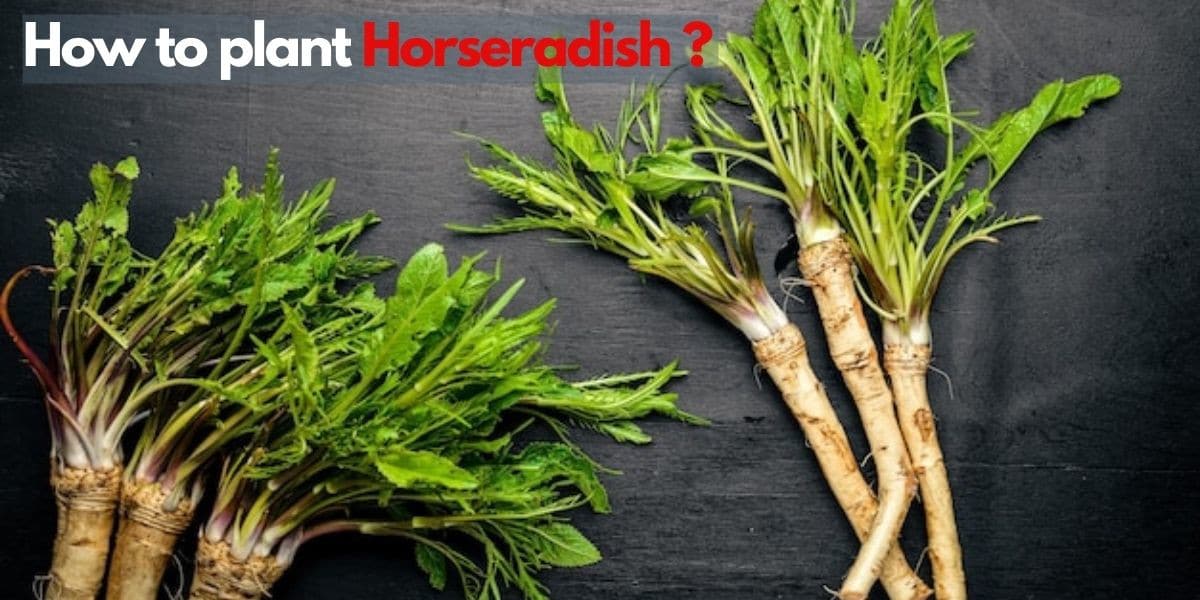Planting, Growing, and Harvesting Horseradish Plant
Planting Horseradish, Horseradish is a lasting vegetable or spice that is developed for its strong roots. This is the very horseradish that the vast majority purchase in a container and use to zest up various dishes, from cook hamburger to mixed drink sauce, and to finish a Passover Seder plate. You can eat horseradish leaves when they are youthful and delicate, yet they ought not to be eaten by creatures since they are somewhat harmful.
Table Of Contents
History Nutrition Planting Harvesting
Overview
Biological Name
Armoracia rusticana
Plant Type
Perennial herb
Maturity Period
140 to 160 days
Maturity Size
12 to 18 inches tall
Soil Type
Loose, rich soil
Soil pH
Neutral (6.0 to 7.5)
Exposure
Full sun
Hardiness (USDA Zone)
3,4,5,6,7
Spacing
2 inches
Bloom Time
N/A
Toxity
Toxic to livestock
Flower Color
White
Growth Rate
140 to 160 day
Native Zone
Central Europe
Maintenance
Feed or side-dress your plants each three to about a month. You can prepare with manure, manure tea, or a business 10-10-10 vegetable compost (adhering to the item guidelines).
History of Horseradish Plant
An extraordinarily tough enduring, horseradish has a place with the respected plant family Cruciferae (“cross-bearing,” for the tiny, cross-shape blossoms regular for all individuals from this family), which incorporates cabbage, broccoli, cauliflower, brussels sprouts, among other regularly developed vegetables.
Horseradish sends up coarse, lengthened, emerald green leaves that take after those of regular wavy dock. This foliage, which infrequently develops multiple feet tall, gives a false representation of the genuine activity underground: In rich soil, the stout horseradish taproot can infiltrate as profound as 10 feet whenever left undisturbed for quite a while. It will convey a tangled mass of flat optional roots and rootlets over a measurement of a few feet.
Nutritional Facts Of Horseradish
Horseradish roots sneak up suddenly that couple of developed plants, and indeed no other root crop can coordinate. The newly ground seed contains more nutrient C than most basic organic products, including oranges. The root is plentiful in calcium, iron, thiamine, potassium, magnesium, minor elements, and proteins, yet attractively low in phosphorus and sodium. Horseradish is multiple times more extravagant in calcium than the potato (with skin) and contains almost multiple times the nutrient C and numerous times the iron.
Planting Horseradish
Best Time of Planting Horseradish
Plant horseradish sets—little bits of horseradish root—So it can Work in the late winter when dirty.
Horseradish requires a long-developing season, so plan to gather in the fall (not long before a freeze) or late winter of the following year.
Growing as a yearly: To get enormous horseradish roots like the ones you buy in a store, consider exploring different avenues regarding developing the plant yearly, zeroing in on getting one giant seed instead of numerous more modest roots. First-year attaches will, in general, be the most impactful.
Start with a bed arranged with bunches of natural matter, and plant the roots as you would in the ground. As the plant begins to develop, it will send up various shoots. Each shoot is framing tiny seeds and taking energy from the plant. To get one enormous root, eliminate everything except a couple of the nodes and permit them to become more prominent.
How To Plant Horseradish
- Horseradish has long taproots, so decidedly ready soil is significant since it is challenging to address the condition once a perpetual plant is set up. Make excellent soil conditions in the nursery bed by turning a few crawls of natural matter.
- Develop new horseradish plants with bits of root about the finger’s width and 12 to 18 inches in length. It will immediately spread, so you will not require multiple or two plants to take care of the entire family.
- Burrow openings around 6 to 8 inches down and 12 inches separated. Plant one root for every space at a 45-degree point with the crown, or enormous end, close to the top at the dirt line and the shortstop at the foundation of the opening. Inlay the door to cover the crown of the root with 2 to 4 crawls of soil, then, at that point, water the plant well.
Planting Horseradish bulbs
Develop horseradish from plants or root cuttings set out in spring or fall. You will not have the option to discover seeds, yet roots are regularly accessible at ranchers’ business sectors, stores, and retail and mail-request nurseries. (Root cuttings from nurseries, for the most part, come precut and should be planted.)
Remove the top third to half of the root to use in the kitchen, saving the base part to plant. Slacken the dirt to 12 inches down and add a shovelful of fertilizer. Plant the rooted cutting at a 45-degree point, with the highest point of the cutting two creeps beneath the dirt line.
One plant is typically a lot for a family. Develop horseradish from plants or root cuttings set out in spring or fall. You will not have the option to discover seeds, yet roots are regularly accessible at ranchers’ business sectors, stores, and retail and mail-request nurseries. (Root cuttings from nurseries, for the most part, come precut and should be planted.
Planting Horseradish in Containers
One develops Horseradish for its impactful, fiery taproot. The actual plant grows in bunches with the leaves emanating out from that root. It extends to between 2-3 feet (.6-.9 m.) in stature. The plates might be heart molded, tightening, or a blend of both and might be smooth, crinkled, or lobed.
The plant blossoms in pre-summer to late spring and becomes an organic product that contains 4-6 seeds. The entire taproot, which can arrive more than a foot (30 cm.) long, is grayish to light tan. Root as the whole framework can be a few feet in length! That is the reason holder developed horseradish is a good thought. You would need to burrow a hell of an opening to get the entirety of the root framework out, and, if you don’t, here it returns once more and intensely the following season!
When planting horseradish in pots, pick a bank with seepage openings and is adequately profound to energize root development (24-36 inches (.6-.9 m.) deep). Even though horseradish is cold brutal, plant your compartment-developed root after all ice has passed or start it inside.
Take a 2″ (5 cm.) piece of root cut at a 45-degree.
How To Harvest Horseradish
- Landscapers differ concerning whether spring-burrowed or pre-winter burrowed horseradish gives the best flavour. However, most concur that roots dove in summer is unpalatable.
- We will, in general, burrow our fundamental stock of roots in late October or early November, after the foliage is killed by ice and not long before the ground freezes.
- Utilize a nursery fork or scoop and cautiously uncover the roots.
- Spring-planted horseradish roots will be prepared to collect in October or November. Gather the seeds in the fall, preferably after the principal ice.
- Burrow around the foundation of the plant and lift the enormous, focal root and whatever number of the more modest origins as could reasonably be expected.
- In ice-free environments, winter collection is suggested. On the off chance that you need to eat some youthful horseradish greens, reap them before the bugs eat many such openings in them. They develop back in a week or something like that.
How To Store Horseradish
- To get ready for storage, trim foliage down to around 1 inch and clean the roots under running water, scouring off any earth. Permit roots to dry before putting away.
- Store horseradish in wet sand in the root basement, in a shaded region. Temperatures shouldn’t dip under freezing.
- A little stockpile of roots will keep well in a punctured plastic pack in the cooler for up to a few months for more prompt use.
- Two admonitions administer both culinary employments of horseradish:
- Keep the roots refrigerated to keep up the flavor and dietary benefit, grinding them just on a case by case basis, and use them crudely.
- While adding horseradish to hot food varieties, like rarebits, sauces, or fondues, the mix is not long before serving.
Propagating of Planting Horseradish
On the off chance that you are developing your horseradish as a lasting, you can leave some in the ground and gather depending on the situation.
Remember that the more broken pieces left in the ground, the more plants you will have the following developing season.
Then again, you can lift the entirety of the roots and save some for planting the following year.
Uncovering the whole plant and saving pieces is regularly the favored strategy since horseradish can get forceful.
Variety of Horseradish Plant
Common horseradish has wide, crinkled leaves with a predominant root quality. Notwithstanding, it is more helpless to infection.
Bohemian horseradish has smaller, smoother leaves than basic horseradish and is more infection safe, yet has a marginally lower-quality root.
Pests And Diseases
Hardly any irritations will trouble the foundations of horseradish. However, a few will benefit from the leaves, including aphids, beet leafhopper, diamondback moth, bug scarabs, and imported crucifer weevil. If other vermin become an aggravation, consider developing your horseradish secret.
Prepare set up horseradish in the late winter (the plants make overwhelming top development the entire summer and afterward start putting away starch in the root in the fall, which stuffs them).
Water and weed consistently; however, weed cautiously when plants are as yet youthful.
Secure the harvests against those nuisances that generally assault cabbage relatives, similar to cabbage worms and creepy insect crawlies.
To forestall the wild spread of the roots and development of infection life forms, gather the seeds consistently—in a perfect world, each spring or fall—and turn the bed to another spot sometimes, setting pencil-size sets severed the fundamental roots.
Recipe
FAQ
Where is the best place of planting Horseradish?
How long does it take to grow horseradish?

